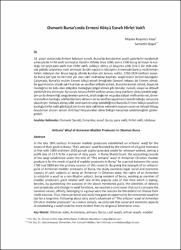Osmanlı Bursa’sında Ermeni Kökçü Esnafı Hirfet Vakfı
Künye
KOYUNCU KAYA, Miyase, & Samettin BAŞOL. "Osmanlı Bursa’sında Ermeni Kökçü Esnafı Hirfet Vakfı." Vakıflar Dergisi, 47 (2017): 25-44.Özet
18. yüzyıl sonlarında Ermeni kökciyan esnafı, Bursa’da loncalarının çeşitli giderlerini karşılamak
amacıyla bir hirfet vakfı kurmuştur. Esnafın ittifakla önce 1000, sonra 1500 kuruş sermaye ile kurduğu
bir çeşit para vakfı olan hirfet vakfı, yaklaşık altmış yıl boyunca yıllık %12,5 kâr elde edecek
şekilde taliplerine kredi vermiştir. Evkâf-ı nasârâ-yı kökciyân-ı Ermeniyân berâ-yı mühimmât-ı
hirfet-i kökciyan der Brusa başlığı altında kurulan söz konusu vakfın, 1760-1824 tarihleri arasında
Bursa Şer’iyye Sicilleri’nde yer alan vakıf muhasebe kayıtları, araştırmanın birincil kaynağıdır.
Çalışmada, Bursa’da mukim Ermeni kökçü esnafı örneğinde Osmanlı tebaası bir Ermeni olmak,
bir gayrimüslim olarak vakıf kurmak ve vakıftan istifade etmek, Bursa’da ikamet etmek, boyacılık
mesleğinin bir kolu olan kökçülük mesleğiyle iştigal etmek gibi konular, hukukî, sosyal ve iktisadî
yönleriyle ele alınmıştır. Ayrıca söz konusu hirfet vakfının amacı, borç alanların süreç içindeki değişim
ya da devamlılığı sorgulanırken yakınlık, ortak değerler ve gruba aidiyet mefhumlarının, Ermeni
esnafının kurduğu vakıflardan borç almanın ve bu vakıfları yaşatmanın sebebi olduğu sonucuna
ulaşılmıştır. Yaklaşık altmış yıllık serencamını takip edebildiğimiz Bursa’da Ermeni kökçü esnafının
kurduğu hirfet vakfı gibi küçük bir örnek dahi vakfetme eyleminin toplum yararı ve iktisadi ihtiyaç
boyutunun zaman zaman dinî/hayrî boyutundan daha belirgin karşımıza çıkabileceğinin göstergesidir. In the late 18th century Armenian madder producers established an artisans’ waqf for the
needs of their guild in Bursa. Their artisans’ waqf founded by the consent of all guild members
at first with 1000 and then 1500 gurush capital provided credit for whoever wished, aiming a
profit rate of 12.5 % for a period of sixty years. In Bursa Sharia Court, the accounting records
of the waqf established under the title of “The artisans’ waqf of Armenian Christian madder
producers for the needs of guild of madder producers in Bursa” for a period between the years
1760 and 1824 are the primary sources of this research. By giving the example of an artisans’
guild of Armenian madder producers of Bursa, the study examines legal, social and economic
aspects of such subjects as being an Armenian in Ottoman state, the rights of an Armenian
to establish a waqf as a non Muslim subject, being resident of Bursa, working as member of
madder producers’ guild related with one of the popular jobs of that time which is dyeing.
Besides, by questioning the purpose of the above mentioned guild, the identities of debtors
and perpetuity and change in waqf functions, we reached a conclusion that such concepts like
common values, affinity, belonging to a group were the reasons for the debtors to choose their
credit sources. Thus, these personal and social ties gave an opportunity for concerned waqfs to
last for a long time. Following about sixty year’s adventure of “The artisans’ waqf of Armenian
Christian madder producers” as a minor sample, we conclude that social and economic aspects
of establishing a waqf could be more evident than its religious/ benefactor ones.
Bağlantı
http://dergipark.gov.tr/uploads/issuefiles/80f7/5b2e/53ef/596e300775e01.pdfhttps://hdl.handle.net/11352/2612
Koleksiyonlar
- Vakıflar Dergisi [825]



















